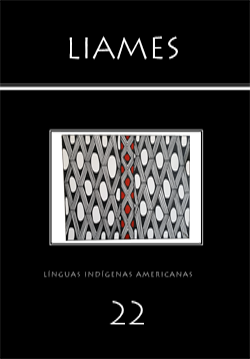Abstract
Ka'apor sign language does not have any words denoting a specific color. In addition to this supposedly curious fact, there is another even more revealing and apparently contradictory: there is a sign that designates the generic idea of color. This is not everything. The color sign is also used in the gesticulation that accompanies the spoken Ka'apor language, which does not have a lexical item designating the concept of color. Therefore, spoken Ka'apor presents a gesture for the generic idea of color and terms for specific colors in speech. Based on these data, I resume a general discussion about the semantics of specific colors, arguing that this is not a fundamental domain of human languages (Wierzbicka 2008). Furthermore, I argue that the gestural modality, although it is a visual channel, is rebellious to the reference of colors: sign languages, therefore, do not adapt to the idea of the basic color terms, as formulated by Berlin and Kay (1969). I cite the case of Libras, the Yolŋu people's sign language, and the Top Hill sign language. Finally, I observe that if the Ka'apor sign language ignores the specific terms for colors, the mythical Ka'apor thought, known by deaf and hearing people, conceptualizes the excess of colors as something harmful - a fact that has already been demonstrated by the comparative analysis of myths (Lévi-Strauss 1964). This article is a review and continuation of the work by Ferreira and Siqueira (1985) who compared the sign language of the Ka’apor people with Libras.
References
Aniz, Vitória; Godoy, Gustavo (2020). Documentation and description of Ka’apor Sign Language. London: SOAS University of London, Endangered Languages Archive. http://hdl.handle.net/2196/31e54111-bf0d-4477-8b37-b845ce76d837
Adone, Dany; Bauer, Anastasia; Cumberbatch, Keren; Maypilama, Elaine L. (2012). Colour sign in two indigenous sign languages. In Ulrike Zeshan; Connie de Vos (eds.). Sign languages in village communities: Anthropological and linguistic insights, pp. 53–86.
Boston/Berlin; Nijmegen: Walter de Gruyter; Ishara Press.
Berlin, Brent; Kay, Paul (1969). Basic color terms. Berkeley: University of California Press.
Ferreira, Lucinda; Siqueira, Elizabeth Angélica Santos (1985 [1988]). Termos básicos para cores em línguas dos sinais. Anais do X Encontro Nacional de Linguística. pp. 508-520. Rio de Janeiro.
Ferreira, Lucinda (s/d). At least two sign languages in Brazil: one among Urubu-Kaapor Indians and another in São Paulo.
https://amerindias.github.io/referencias/bri84twosignlanguages.pdf
Ferreira, Lucinda (1983 [1985]). A comparative study of signs for Time and Space in Sao Paolo and Urubu-Kaapor sign language. SLR 83: Proceedings of the 3rd International Symposium on Sign Language Research. pp. 22–26 Silver Spring, MD; Roma: Linstok Press; Istituto di psicologia, CNR.
Ferreira, Lucinda (1984). Similarities and differences in two Brazilian sign languages. Sign Languages Studies (42): 45-56. https://www.jstor.org/stable/26203575
Ferreira, Lucinda (1995 [2010]). Termos básicos para cores em línguas de sinais (Capítulo 8). Por uma gramática de língua de sinais, pp. 159–169. Rio de Janeiro: Tempo brasileiro.
Godoy, Gustavo (2020a). Os Ka'apor, os gestos e os sinais (Tese doutorado em Antropologia Social). Rio de Janeiro: PPGAS, UFRJ.
Godoy, Gustavo (2020b). É o tempo dos gestos nos sinais. Linguíʃtica 16(3): 60-102
Kay, Paul; McDaniel, Chad K. (1978). The linguistic significance of the meanings of basic color terms. Language 54(3): 610-646. 10.1353/lan.1978.0035
Lakoff, George; Johnson, Mark (1980). The metaphorical structure of the human conceptual system. Cognitive Science 4(2): 195-208.mhttps://doi.org/10.1016/S0364-0213(80)80017-6
Levinson, Stephen C. (2000). Yélî Dnye and the theory of basic color terms. Journal of Linguistic Anthropology 10(1): 3-55. https://doi.org/10.1525/jlin.2000.10.1.3
Lévi-Strauss, Claude (1964). Le cru et le cuit. Paris: Plon.
Kakumasu, James Y. (1968). Urubu-Kaapor Sign Language. International Journal of American Linguistics 34(4): 275–281. https://doi.org/10.1086/465027
Morphy, Howard (2006). From dull to brilliant: the aesthetics of spiritual power among the Yolŋu. In Morgan Perkins; Howard Morphy (eds.), Anthropology of art: a reader, pp. 302–320). Oxford: Blackwell Publishing.
Ribeiro, Darcy (1996). Diários Índios: os Urubus-Kaapor. São Paulo: Companhia das Letras.
Talmy, Leonard (2000). Toward a cognitive semantics – Volume I: Concept structuring systems. Cambridge, Massachusetts and London, England: The MIT Press.
Wierzbicka, Anna (1986). What’s in a noun? (Or: how do nouns differ in meaning from adjectives?). Studies in Language 10(2): 353–389. https://doi.org/10.1075/sl.10.2.05wie
Wierzbicka, Anna (1988). The semantics of grammar. Amsterdam/Philadelphia: John Benjamins Publishing Company.
Wierzbicka, Anna (1992). Semantics, culture and cognition: Universal human concepts in culture-specific configurations. New York; Oxford: Oxford University Press.
Wierzbicka, Anna (2006). The semantics of colour: A new paradigm. In Carole P. Biggam; Christian J. Kay (eds.), Progress in Colour Studies, vol. I: Language and Culture, pp. 1-24. Amsterdam/Philadelphia: John Benjamins Publishing Company.
Wierzbicka, Anna (2008). Why there are no “colour universals” in language and thought. The Journal of the Royal Anthropological Institute 14(2): 407–425. https://doi.org/10.1111/j.1467-9655.2008.00509.x

This work is licensed under a Creative Commons Attribution-NonCommercial 4.0 International License.
Copyright (c) 2022 Gustavo de Godoy e Silva


